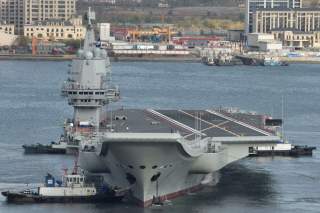Why Would Russia Ever Help China Build a Nuclear Aircraft Carrier?
How does this make any sense?
Key point: Both China and Russia are eager to match the United States' nuclear powered fleet.
It appears that China is relying on Russian know-how and experience to develop the reactor for its first nuclear aircraft carrier. As the South China Morning Post reports, China appears to be studying the nuclear reactors on Russia’s largest icebreakers, an approach that the Soviet Union also took when it planned to build nuclear carriers in the 1980s. Specifically, Russia has invited China to bid on the construction of a new class of nuclear icebreaker, necessarily requiring the development of surface-ship based reactors. This approach stands in contrast to how the United States and France developed nuclear reactors for their largest carriers, but probably represents the best choice for China at this point.
History:
To appreciate what’s at stake in China’s pursuit of nuclear-powered surface warships, it’s important to review the experience of the United States and the USSR. After the successful development of the USS Nautilus and the Skate class nuclear attack submarines (as well as the merchant ship NS Savannah) provided proof-of-concept regarding nuclear propulsion, the USN began to evaluate nuclear power for surface warships. The first USN nuclear surface warship was the cruiser USS Long Beach, commissioned in 1961. Long Beach was powered by 2 C1WS reactors, generating around 120 MW, enough power to produce a speed of 30 knots for the 17,000-ton cruiser hull. The USN rapidly followed up with USS Enterprise, powered by 8 A2W reactors, each quite similar in construction and output to the C1W. Those reactors generated 120 MW each, translating to 280,000 SHP, driving the 100,000-ton Enterprise at up to 33 knots.
A few other nuclear cruisers and destroyers followed, but the advantages of nuclear power in surface warfare ships was limited by cost. Aircraft carriers were a different story. The Nimitz class, which began to enter service in 1975, use two A4W reactors, each rated at 550 MW. The recently commissioned USS Gerald R. Ford carries two A1B reactors, capable of generating 700 MW. The extra power generation capacity of the Fords has little to do with speed. Rather, the power provides a surplus usable for a variety of different systems, including EMALS and highly sophisticated sensors. Down the road, the extra energy may power point-defense lasers and similar equipment. Overall, the reactors open up space to modernize and modify the Ford-class vessels, keeping them effective for their decades of project life.
The Soviet Experience:
The Soviet experience was somewhat different. While the Soviets enjoyed considerable success in developing nuclear reactors for submarines, they approached the question of surface warships much more carefully. The first nuclear powered Soviet ship was the icebreaker Lenin, commissioned in 1959 with three OK-150 reactors (90 MW each). Between 1975 and 1990, the Soviets would commission nine more nuclear icebreakers of the Arktika and Taymyr classes, generally displacing between 20,000 and 25,000 tons and carrying two OK-900 reactors, capable of 150 MW.
These ships provided valuable experience, but the Soviets were slow to make the leap to nuclear-powered surface combatants, in part because Soviet warships were expected to operate closer to home than their U.S. counterparts. In 1974, however, the Soviets began building the first of four ships of the Kirov class, 26,000-ton battlecruisers with both nuclear and conventional propulsion. Reports differ on the power capacity of the two KN-3 reactors, with a range from 150 MW to 300 MW. These reactors would also have powered the Ulyanovsk class supercarriers, a class of ships that was canceled upon the collapse of the USSR.
What China Wants:
The Chinese are undoubtedly thinking along lines similar to those of the late Soviets. Expectations for Carrier 004 (003 will be a conventional CATOBAR carrier) suggest a ship roughly the size and sophistication of the Ford-class, which of course would require immense power-generation capabilities. Like the United States, China wants excess power generation in order to field a suite of future weapons and sensors. For this purpose, China needs reactors more powerful than those that it currently uses on its submarines, and building icebreakers for Russia may provide the necessary experience.
This approach stands in contrast to that of the French Navy, which decided to upscale based on experience building nuclear reactors for submarines. While France has enjoyed success with nuclear subs, the Charles De Gaulle is widely believed to be underpowered relative to other fleet carriers. Charles de Gaulle uses two Areva K15 reactors, the same type as employed on French submarines. These reactors provide 150 MW each, but only drive the 43,000-ton carrier some 27 knots. It’s worth noting that India considered, but wisely rejected, the idea of building INS Vishal as a nuclear carrier, largely because of the technical challenges of developing a powerful enough reactor.
Parting Thoughts:
The idea of using Russian technical data and nuclear know-how certainly makes sense from the perspective of the People’s Liberation Army Navy. The PLAN doesn’t have the luxury of the incremental approach adopted by the United States, and has good reason to find the French approach insufficient to its needs. That the Russians seem okay with letting the Chinese study their icebreakers suggests, once again, that Moscow and Beijing currently see cooperation as in their long-term interests. Of course, nothing will be certain until China’s first nuclear carrier actually enters service, perhaps sometime around 2030.
Robert Farley is a frequent contributor to TNI. This first appeared in July 2019 and is being republished due to reader's interest.
Image: Reuters

